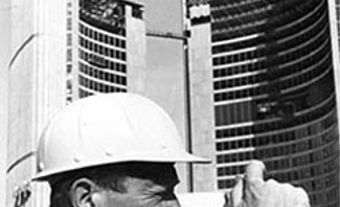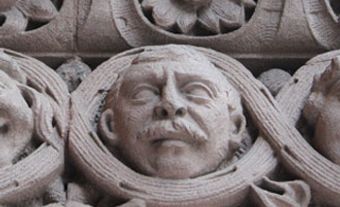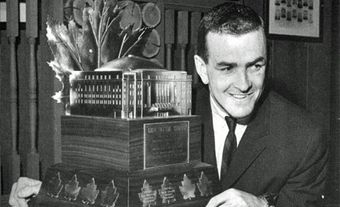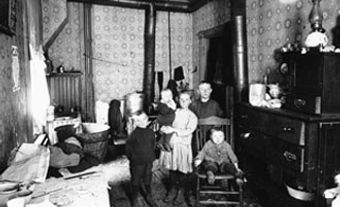Nathan Phillips, QC, lawyer, politician, mayor of Toronto 1955–62 (born 7 November 1892 in Brockville, ON; died 7 January 1976 in Toronto, ON). Known affectionately as “the mayor of all the people,” Nathan Phillips was Toronto’s first Jewish mayor. His mayoralty marked a turning point in the city’s history as it transitioned from a Protestant enclave to a multicultural metropolis. He was influential in demolishing old buildings and neighbourhoods to create a more modern cityscape. He was also a key figure behind the innovatively designed New City Hall and the large public space in front of it, which was named Nathan Phillips Square in his honour.

Early Life and Family
Nathan Phillips was born in Brockville, Ontario, to Jacob Phillips and Mary Rosenbloom. His father ran a small haberdashery business. Phillips and his brother and four sisters grew up in Cornwall, Ontario, where they attended public elementary and secondary schools.
When he was 10 years old, Phillips decided he would become a lawyer. For two years, he was a clerk for Cornwall lawyer Robert Smith, who later served as a justice on the Supreme Court of Canada. To supplement some financial assistance from an uncle that helped him attend law school, Phillips started a photography business. He photographed babies and weddings and such, developing the prints himself. Photography became a lifelong hobby.
Phillips graduated from Toronto’s Osgoode Hall Law School in 1913 and was called to the bar later that year. In 1929, he was appointed King’s Counsel; at 36 years old, he was believed to be the youngest in Ontario’s history and possibly in Commonwealth history. He provided defence at various trials and later also served as a crown prosecutor.
Phillips married Etta Lyons in 1917. They had three children: Lewis, Madeline and Howard. Lewis died tragically at age 11 after being hit by an automobile. Howard served as a Toronto city alderman for Ward 3 from 1949 until his retirement in 1957. He and his father were the first father-son duo to serve on the council at the same time.

Entering Politics
In the 1935 federal election, Phillips ran as the Conservative Party’s candidate in the Toronto riding of Spadina. That bid was unsuccessful, as were his efforts to win provincial office in the riding of St. Andrews in 1937 and again in 1948.
Phillips enjoyed much more electoral success at the municipal level. On 1 January 1924, he won his first election for Toronto City Council, taking one of three available seats to represent the ethnically diverse Ward 4. He won re-election 27 consecutive times.
In 1951 and 1952, Phillips ran unsuccessfully for the office of mayor of Toronto. His candidacy was controversial because his election would make him the city’s first Jewish mayor. Toronto had long been a bastion of Protestant control in business and politics. For 100 years prior to Phillips’ candidacy, every Toronto mayor had been Protestant and a member of the Orange Order, an influential fraternal society that defended British, Protestant ideals.
In 1955, incumbent mayor Leslie Saunders, who was also the Deputy Grand Master of the Ontario Orange Order, chose to make the preservation of Protestant power in Toronto a central plank of his re-election campaign; he even went so far as to equate his re-election with the 1690 Battle of the Boyne, which had pitted Protestants against a non-Protestant enemy. After being told about this statement by a reporter, Phillips decided to enter the mayoral race a third time.
In the end, Saunders’s strategy proved to be out of step with the increasingly multicultural population of Toronto. Phillips’s victory marked an important turning point in the city’s history as it transitioned from a Protestant enclave to a multicultural metropolis. He said in his victory speech: “I shall represent all the people, and I mean all the people in the broadest sense, fairly and without discrimination. I shall cut intolerance, wherever it shows itself, at its roots. In plain language, I will try and be you, all the people of Toronto, and reflect your aims, ideals, aspirations and ambitions.” Phillips henceforth became known as “the Mayor of All the People.”
Tenure as Mayor
Phillips believed that the role of mayor was not just to promote the city but also to establish strategic goals and achieve them by earning the support of councillors and the community. He said, “There are people who are better qualified than I to work out the details, and they are paid for that. The mayor’s function is to initiate broad plans for the betterment of this great city.” The broad plans during Phillips’ tenure as mayor included the initiation of an east-west subway line, and the construction of a new civic auditorium (the O’Keefe Centre, now Meridian Hall) and a new public square.
In 1955, Phillips led the effort to have council approve a modernist-inspired plan to create a new city hall and public square. In 1958, an international contest led to the acceptance of a plan by Finnish architect Viljo Revell. New City Hall would consist of two tall, concave towers, with one of Canada’s biggest public squares in front.
To make room for the project, homes and businesses in the Chinatown area of The Ward neighbourhood were expropriated by the city and demolished. On 7 November 1961 — his 69th birthday — Phillips participated in a groundbreaking ceremony to begin the construction of the new city hall and what had already been named Nathan Phillips Square.
Phillips won re-election as mayor four times. His gregarious personality, playful sense of humour and uncanny ability to remember names served him well, as he became well-liked throughout the city. He and Etta, his wife of nearly 60 years, were fixtures at events of all kinds. True to his promise, Phillips promoted the acceptance of ethnic differences as Toronto became more racially diverse.
Phillips’ main opponent in the 1962 municipal election was Donald Summerville, who had been an alderman since 1955. He convinced voters that it was time for a change. Summerville won a majority of votes in every ward, thereby ending Phillips’ political career.
Legacy
Nathan Phillips returned to his law practice, where his principal concerns were reforming divorce law and working toward gender equity for women. Even though he was out of office, many people continued to call him Mr. Mayor. On 13 September 1965, Phillips was a guest of honour at the opening of the new city hall and the 4.85-hectare Nathan Phillips Square. Phillips was praised for his leadership and vision and received the Civic Award of Merit from Governor General Georges Vanier.
Phillips died of a heart condition on 7 January 1976. His obituary in the Toronto Star read in part: “To countless newcomers, he made Toronto seem a friendlier place, and he gave them a sense of being citizens and not strangers. There was a great deal of truth in the title he loved to give himself, ‘The mayor of all the people.’”


 Share on Facebook
Share on Facebook Share on X
Share on X Share by Email
Share by Email Share on Google Classroom
Share on Google Classroom







